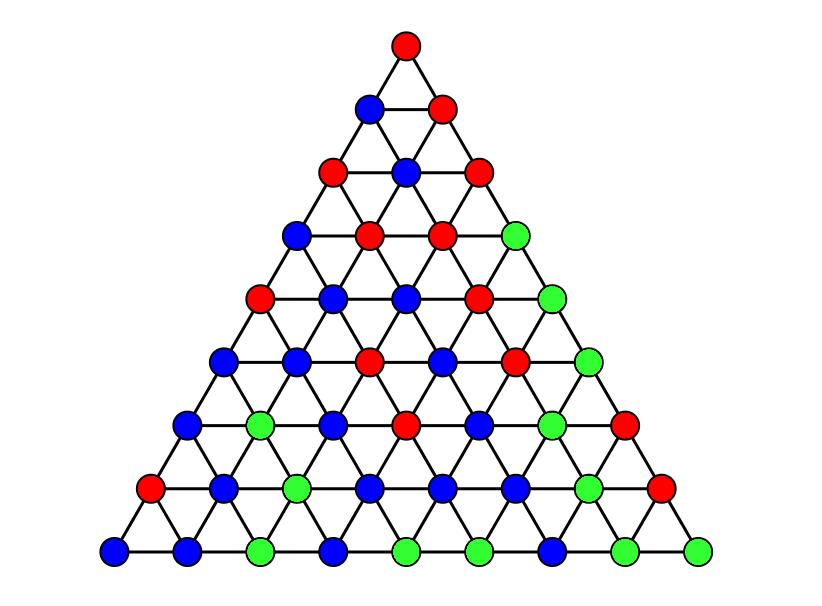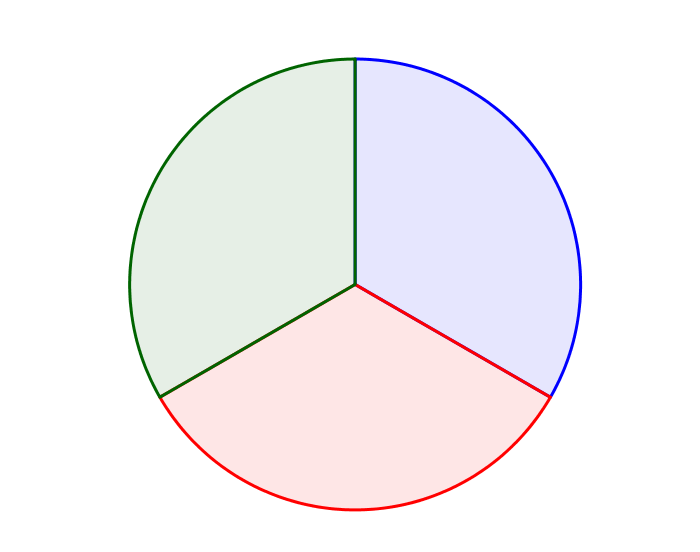This is one of three sets of fixed point exercises. The first post in this sequence is here, giving context.
1. (1-D Sperner's lemma) Consider a path built out of edges as shown. Color each vertex blue or green such that the leftmost vertex is blue and the rightmost vertex is green. Show that an odd number of the edges will be bichromatic.

2. (Intermediate value theorem) The Bolzano-Weierstrass theorem states that any bounded sequence in has a convergent subsequence. The intermediate value theorem states that if you have a continuous function such that and , then there exists an such that . Prove the intermediate value theorem. It may be helpful later on if your proof uses 1-D Sperner's lemma and the Bolzano-Weierstrass theorem
3. (1-D Brouwer fixed point theorem) Show that any continuous function has a fixed point (i.e. a point with ). Why is this not true for the open interval ?
4. (2-D Sperner's lemma) Consider a triangle built out of smaller triangles as shown. Color each vertex red, blue, or green, such that none of the vertices on the large bottom edge are red, none of the vertices on the large left edge are green, and none of the vertices on the large right edge are blue. Show that an odd number of the small triangles will be trichromatic.

5. Color the all the points in the disk as shown. Let be a continuous function from a closed triangle to the disk, such that the bottom edge is sent to non-red points, the left edge is sent to non-green points, and the right edge is sent to non-blue points. Show that sends some point in the triangle to the center.

6. Show that any continuous function from closed triangle to itself has a fixed point.
7. (2-D Brouwer fixed point theorem) Show that any continuous function from a compact convex subset of to itself has a fixed point. (You may use the fact that given any closed convex subset of , the function from to which projects each point to the nearest point in is well defined and continuous.)
8. Reflect on how non-constructive all of the above fixed-point findings are. Find a parameterized class of functions where for each , , and the function is continuous, but there is no continuous way to pick out a single fixed point from each function (i.e. no continuous function such that is a fixed point of for all ).
9. (Sperner's lemma) Generalize exercises 1 and 4 to an arbitrary dimension simplex.
10. (Brouwer fixed point theorem) Show that any continuous function from a compact convex subset of to itself has a fixed point.
11. Given two nonempty compact subsets , the Hausdorff distance between them is the supremum
over all points in either subset of the distance from that point to the other subset. We call a set valued function a continuous Hausdorff limit if there is a sequence of continuous functions from to whose graphs, , converge to the graph of , , in Hausdorff distance. Show that every continuous Hausdorff limit from a compact convex subset of to itself has a fixed point (a point such that ).
12. Let and be nonempty compact convex subsets of . We say that a set valued function, is a Kakutani function if the graph of , , is closed, and is convex and nonempty for all . For example, we could take and to be the interval , and we could have send each to , map to the whole interval , and map to . Show that every Kakutani function is a continuous Hausdorff limit. (Hint: Start with the case where is a unit cube. Construct by breaking into small cubes of side length . Constuct a smaller cube of side length within each cube. Send each small to the convex hull of the images of all points in the cube with a continuous function, and glue these together with straight lines. Make sure you don't accidentally get extra limit points.)
13. (Kakutani fixed point theorem) Show that every Kakutani function from a compact convex subset of to itself has a fixed point.
Please use the spoilers feature - the symbol '>' followed by '!' followed by space -in your comments to hide all solutions, partial solutions, and other discussions of the math. The comments will be moderated strictly to hide spoilers!
I recommend putting all the object level points in spoilers and leaving metadata outside of the spoilers, like so: "I think I've solved problem #5, here's my solution <spoilers>" or "I'd like help with problem #3, here's what I understand <spoilers>" so that people can choose what to read.
Ex 9
I'm weak with high-dimensional stuff, so I wanted to translate the statement into one about graphs. We characterize graphs by the following property:
Property P: every j-clique in the graph has an equal number of extensions to (j+1)-cliques. (I.e., an equal number of nodes not in the clique that are connected to every node in the clique.)
(A simplex we translate into a graph has property P: every vertex has an equal number of edges it's a part of, every edge an equal number of faces it's a part of, and so on. That is, except for the vertices/edges at the... well, edges of the triangulation. Those have already made problems in Ex4.)
We now prove by induction that, given any k∈N and a graph with property P where the largest cliques are k-cliques, and any coloring c:V→{1,...,k}, the graph has an even number of k-chromatic cliques.
Base case is k=2. The only such graph with property P is the cycle graph Cn. Lemma follows from Ex. 1. (We need that n≥3 here, but that's fine.)
Inductive step: suppose the claim is true for some k∈N and we have a graph where the largest cliques are k+1 cliques and some coloring c:V→{1,...,k+1}. We prove the step by constructing c starting with the trivial coloring c′ where c′≡1. This coloring has no k+1-chromatic cliques, so in particular, the number of such cliques is even. We can transform c′ into c by repeatedly recoloring nodes, as in Ex4 -- and as in Ex4, the claim follows if we can prove that any step changes the number of k+1-chromatic cliques by an even number.
Let x∈V, and suppose we change the color of x from n to m. Recoloring x can only change the k+1-chromatic-ness of cliques which contain x. Let ω be such a clique. Then ω changes its k+1-chromatic-ness iff (a) precisely one of the nodes in ω−{x} has color n or m, and (b) the remaining k−1 colors of nodes in ω−{x} are the set {1,...,k+1}−{n,m}. In other words, let (V′,E′) be the subgraph consisting of the neighbors of x plus edges and let c− be the coloring obtained by c if we merge colors m and n into one, then the number of cliques that change their k+1-chromaticness in (V,E) is equal to the number of k-chromatic cliques in (V′,E′).
It now follows from the inductive assumption that the number of such cliques is even. We verify that (V′,E′) has property P: let ρ be a j-clique in (V′,E′). Then, the claim follows from the fact that there is a one-to-one correspondence between j+1 cliques extending ρ in (V′,E′) and j+2 cliques extending ρ∪{x} in (V,E). Furthermore, (V′,E′) has at most k-large cliques since every node was connected to x and thus lost one degree.
Given this, one can start with a triangulation where precisely one simplex is k-chromatic (this is pretty straight-forward) and then use the Lemma to repeatedly recolor vertices without changing the number of k-chromatic simplexes. Except, again, for the simplexes at the edges of the triangulation, but those should work similarly... I hope.